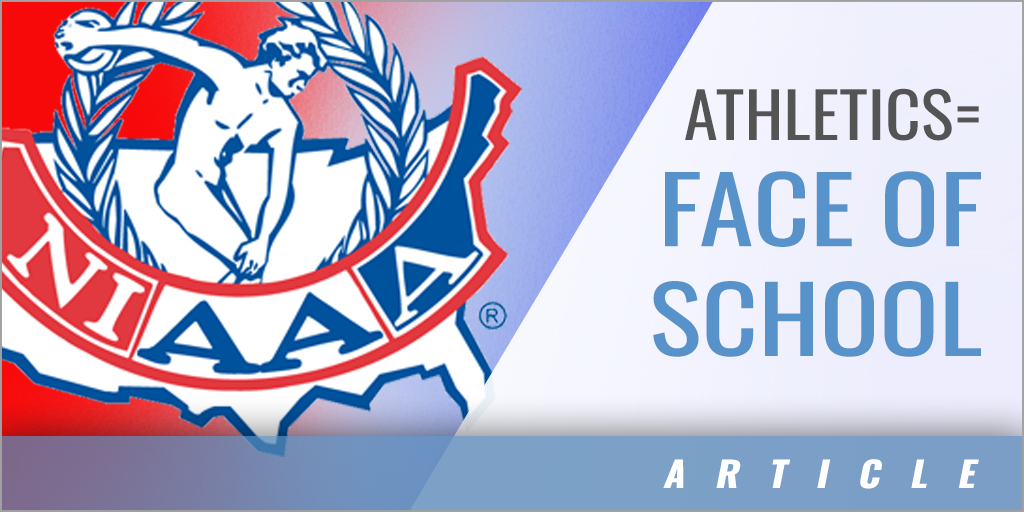|
By: Gary Stevens | Thornton Academy It has often been stated that a high school’s athletic program serves as the “front porch” of the school itself. For many people, their first impressions about a school come from their experiences at high school athletic events. The performance of the school’s athletic teams, the professionalism (or lack thereof) displayed by the program’s coaches, and the behavior of student-athletes or members of the student body in attendance can serve as important indicators about the values that the school teaches or espouses. Similarly, a high school sports program is a critical component of a school’s connections with local residents and alumni. The level of success of a high school program contributes significantly to the sense of identity of both a school system and the communities that comprise it. As suggested in a recent public service announcement produced jointly by the National Interscholastic Athletic Administrators Association (NIAAA) and National Federation of State High School Associations (NFHS), community members wear the colors of the local high school on “Game Day” to emphasize the significance of those connections. Athletic administrators, therefore, should invest time and energy into enhancing their public relations arsenal. Interfacing effectively with individual community members, families, and public institutions serves a number of purposes. During challenging budget times, having a constituency of allies for the school and its athletic program is easily translated into political influence. Whether it is salvaging components of an athletic program that may be under siege due to financial constraints or spearheading efforts for a major project (such as a gymnasium or artificial turf field), those connections can pay dividends. The term “invest” lends itself well to the acronym “I-N-V-E-S-T”, each letter of which represents six major activities or responsibilities that comprise the athletic director’s public relations tool kit. These components include: I – Maintaining a professional image at all times By purposefully I-N-V-E-S-T-I-N-G oneself personally and professionally in these components of the work, an athletic director can actually enhance the position of the athletic program and the school within the community as a whole. I - The Importance of Image Athletic administrators are well reminded that at any given time during a high school event there are multiple eyes upon them. When the lights go out on the scoreboard in the middle of a basketball game, attention shifts to the athletic director to see what his or her reaction will be. In the event that one or more student spectators demonstrate poor sportsmanship during a contest, the public expects that the administrator in charge of the event will respond quickly and assertively to deter or discontinue the behavior. An athletic director’s image becomes the starting point of developing and implementing an effective public relations strategy. It encompasses a number of components – how the athletic director dresses, how he or she manages stressful or challenging situations, and the overall behavior that one exhibits. Image is perception based upon the knowledge and bias of an individual, and athletic administrators are subject to a changing perception about themselves and their schools on a moment’s notice. The connection of image and perception carries itself beyond the playing field as well. The athletic director who demonstrates exemplary behavior within the context of the school can damage his or her reputation just as easily through behaviors witnessed outside the realm of work. For better or worse, one remains the school athletic director whether on the clock or in the public eye after school hours; in many ways, it is a twenty-four hour job. Given this challenge and the pressure to live up to the public’s expectations of a person in a high profile position, a high school athletic administrator should employ the following set of guidelines:
N – Navigating the Challenges of the Job The work of an athletic administrator is one of the most challenging roles in the school. The hours are frequently long, and the athletic director must make some of his or her most important decisions and perform at the highest possible level when his or her energy level is lowest. Managing an in-game interaction with a challenging spectator may occur twelve hours or more hours after arriving at one’s desk for work, and a hasty or impulsive move performed in a sloppy manner can have negative effects for one’s reputation and that of the school for a long period of time. The old adage attributed to an advertisement for a popular deodorant – “Never let them see you sweat” – is sage advice for the athletic director managing the challenging situation. During the heat of a difficult scenario conducted in full view of the public, one must react decisively, yet in a reflective and purposeful manner. At all times, it is critical to trust one’s experiences and training to determine the most appropriate response and to be both polite and professional under pressure. The NIAAA has two courses within its Leadership Training Academy offerings that provide athletic directors with the tools necessary for navigating the challenges that are part of the profession. LTC 714 (Athletic Administration: Dealing with Challenging Personalities) suggests a variety of strategies for interacting with various personality types that one may encounter in one’s work. The emotional intelligence work of Daniel Goleman – based upon the belief that one can control his or her own perceptions of others – is the underlying theme of this course. Similarly LTC 724 (Stress Management Methods, Techniques, and Systems) incorporates methodologies one can employ before, during, and after work to manage difficult situations in a calm, controlled manner. V – The Visibility Factor One of the greatest public relations tools that an athletic director can employ is being visible at a wide variety of athletic events. In addition to having an opportunity to see student-athletes of all abilities compete and to observe the work of coaches first-hand, being present at these contests means that the athletic director is seen by others. Parents of student-athletes will see firsthand that the athletic administrator is interested in the entire program, not just high profile sports that may require additional supervision. Most importantly, these settings provide opportunities to make personal connections with families of student-athletes and to develop relationships that may prove beneficial when managing difficult situations. A number of strategies related to visibility may enhance one’s connections with the public and his or her public image. These ideas include:
E – The Importance of Equity Public relations in the world of high school athletics is largely based upon public perception of the athletic director’s leadership style. Student-athletes, coaches, and parents expect – and rightfully so – that an athletic administrator will treat all programs and all participants in a fair and equitable manner. Although it is understood that some programs may receive more media attention or attract more general interest than others, the athletic director must incorporate a number of strategies in his or her repertoire to ensure that all student-athletes can enjoy a positive experience. In order to demonstrate a commitment to promoting equity among all programs under his or her supervisory umbrella, an athletic director should:
S – Be Social Media Savvy In today’s digital age, an athletic administrator must be skilled in using electronic methods to communicate information and promote the school’s athletic offerings. Many athletic directors operate accounts utilizing social media platforms such as Facebook or Twitter to share scheduling information, report scores, and record the successes of student-athletes and coaches. Most students of the current generation are active consumers of social media and use those methods to communicate regularly. Being a social media user is a great opportunity for an athletic director to demonstrate how to use technology is a positive and productive manner. All Facebook posts or tweets should be centered on celebrating, not criticizing, people. “Likes” and “retweets” should be employed strategically and carefully. Many athletic directors tweet live results or updates while attending athletic events. Although this strategy is an effective means for generating new followers and interest in the athletic program, it also contributes to public perceptions about the athletic administrator. Tweeting details about every possession of the weekly football game while ignoring performance in other activities suggests a narrow focus. An alternative approach is to tweet or report all scores via social media after the event ends and report highlights accordingly. T – Understand the Components of Title IX Title IX of the Education Amendments of 1972 requires that all school units receiving federal funding cannot discriminate based upon gender. Athletic administrators in public schools are legally bound by this landmark legislation to conduct their programs accordingly. Perhaps the worst moment of publicity for any high school athletic program is a successful claim that it has failed to meet the letter – and spirit – of this fundamental guideline. The NIAAA currently explores the specific requirements of Title IX legislation in Leadership Training Course 506, one of the requirements for Certified Athletic Administrator (CAA) status. In the course, athletic administrators not only learn about the language and requirements of Title IX, but how to apply them in an interscholastic athletic setting. The specifics of the “Three-Prong Test” and the P-L-A-Y-I-N-G F-A-I-R” are identified and explored. Furthermore, case law related to these legal components is incorporated into the program to provide today’s athletic administrators to learn from the experiences (and mistakes) of others.
Perhaps no school administrator interfaces with more people on a daily or weekly basis than the school athletic director. In many respects, he or she is “the face of the franchise” for the school district he or she serves. The athletic director is not only responsible for coordinating all aspects (personnel, financial, contest management) related to the school’s sports activities, but also serves as a major public relations arm of the organization. Having the ability to communicate effectively with the general public and to provide services that build strong community relations is no longer a mere asset in the athletic director’s tool kit; it is a must in today’s society. |







